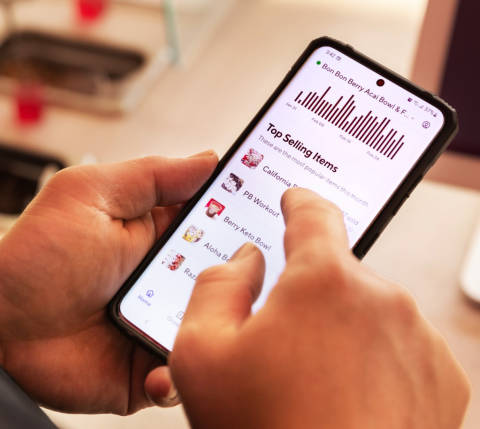Do you have any idea how much data your restaurant has access to? Whether you're processing transactions, getting reviews, drawing visitors to your website or social media channels, or tabulating your inventory, you're generating and gathering huge volumes of information. But to turn that information into actionable, valuable insights, you need to understand restaurant data analytics.
This is your go-to guide for understanding restaurant analytics and how to use them to their full potential to identify past patterns and future trends, make better business decisions, and differentiate yourself from your competitors.
What are restaurant data analytics?
Think about all the data points that come through your point-of-sale (POS) system. Every day, you're provided with a steady stream of numbers tallying order volumes and check sizes, tip amounts, and payment type. It can tell you what was ordered and when to reveal the peaks and valleys in your daily, monthly, and yearly sales. But only a modern analytics platform can synthesize those disparate stats into a coherent story.
It's not just your POS system that can provide raw data. Perhaps you have an online reservation system that can help discern the days and times when guests prefer to dine in-person, or an online ordering platform that shows which takeout and delivery items are most in-demand.
You might have a third-party delivery app like DoorDash, which grants access to a variety of metrics, reports, and dashboards to help you view ordering trends. You may also have a customer relationship management (CRM) tool that lets you deliver more personalized marketing and messaging, or inventory management software to help keep your kitchen stocked.
All of these are great sources of data. They also constitute your restaurant's technology stack, or the hardware and software systems that help you run your business. As you design and refine your tech stack, prioritize tools that supply high-quality data. And make sure these tools support integrations, so they can communicate with each other to consolidate information. A centralized platform is what makes restaurant data analytics possible.
Here's an easy way to enable sophisticated restaurant analytics: partner with a cloud-based, third-party delivery service, and ensure it can integrate seamlessly with your POS. Almost immediately, you'll have a robust platform that can not only collect and parse data, but meaningfully analyze it to provide you with real-time business insights.

Why are restaurant data analytics important?
Harnessing the power of "big data" — having a connected tech stack that consistently collects information on your business transactions — can significantly increase profitability for organizations. This holds true across a range of industries, with profit increases averaging 8% to 10%.
Restaurants in particular stand to benefit, because many already have reliable data sources. Layering in restaurant analytics unlocks huge potential, because unlike restaurant reporting, which simply involves categorizing and displaying data collected over a set time period, analytics compares larger data sets to draw conclusions that are more nuanced and addressable. In other words, while reporting shows you the what, analytics tells you the why.
Learn how DoorDash partners can leverage data in the Merchant Portal to increase sales and provide a better customer experience.
Restaurant analytics allow you to spot what is and isn't working so you can pivot accordingly. Is a particular dish or food trend catching on with your diners? Is one of your servers a master of the upsell? Such insights are invaluable because in the restaurant industry, profit margins can be paper thin — and tiny tweaks to your operations can make a massive difference.
What do restaurant data analytics include?
Determining the key performance indicators (KPIs) most relevant to your restaurant can help you decide what data to prioritize. As their name suggests, KPIs are metrics that can be tracked to get a good sense of how your business is doing overall.
Set impactful KPIs by connecting them to measurable targets. For instance, set goals for profit margins, average order value, social media and website traffic, ad conversion rate, customer ratings and review scores, or food cost percentage. This will help guide how you leverage restaurant analytics to achieve tangible results and make the most of all types of available data.
Sales data
Perhaps the best indicator of your restaurant's revenue comes from your sales data, which is collected across several systems — notably, your POS, online ordering platform, and delivery service. Use this to understand metrics such as the number of orders placed, total order value, revenue, and items that make the most money by being particularly popular or profitable.
Operations data
Your POS system, online reservation service, inventory management solution, and CRM platform can also supply data that shows how your restaurant is functioning. Insight into a range of separate but interconnected processes — for instance, staffing levels, customer traffic, and order accuracy — tells you a lot about where and how your service could improve.
Customer data
Knowing your guests is key. If your data analytics platform is integrated with your POS and CRM data, as well as any loyalty programs you operate, then you can aggregate important information on your guests' behaviors, preferences, and demographics. This can also be gleaned from ratings and reviews, as well as the performance of menu items.
Marketing data
From the number of visits to your website, to views and likes across your social media channels, to the open rates for your email campaigns, your marketing data shows you not only the size of the audience you're reaching, but how engaged they are with your brand. You should also track metrics such as your revenue on special offers and conversion rates on paid ads, so you can evaluate whether promotions are paying off.

How can restaurant analytics improve your business?
A restaurant's data analytics collates information from the past to make intelligent predictions about the future. There are many possible applications, but here are some that can be truly transformative for business owners and their teams.
1. Inform staffing and scheduling
Data analytics are extremely effective for revealing ebbs and flows in online and in-person traffic. Fluctuations can be subtle, but consistent enough to warrant changing how you're scheduling your team. You may also notice patterns in recruitment and retention data to help you dedicate appropriate resources to developing your talent and see where people are dropping off.
2. Enhance your marketing efforts
When you have data-driven insights into which web pages get the most attention, which social media posts gain the most traction, or which special offers are redeemed most, you're equipped with actionable ways to turn prospects into paying guests.
3. Reduce waste and inefficiency
Data analytics are great for spotting recurring operational and inventory issues. The restaurant industry is a major contributor to global food waste, and it's also a blow to your bottom line when you discard ingredients you couldn't use or dump meals that missed the mark.
4. Keep your inventory up to date
An inventory management solution that's integrated with your data analytics platform can proactively alert you about restocking certain items. Past and present stock levels can be cross-referenced with current sales volumes and customer demand in real time, so you always have the necessary supplies when you need them.
5. Assist with menu engineering
It can be difficult to tell at a glance which menu items are driving your business and which aren't worth the cost. Data analytics supply the profit margins on each dish so you can calculate appropriate markup rates and take note of your bestsellers.
6. Personalize your guest services
When data analytics are able to correlate individual customer profiles and contact information with preferred orderings method, favorite dishes, and review or ratings histories, there are limitless opportunities to engage loyal guests with personalized offers — while also helping you elevate the experience for every customer who visits your website or walks through your door.
7. Note popular payment methods
Understanding how your guests prefer to pay is a chance to enhance cost efficiencies. Are you supporting payment methods that people seldom use? Do you have enough terminals so your guests aren't left waiting to pay? Do your QR code menus speed up payments and table turnover?
8. Refine your business objectives
Having robust analytics can show you where to aim in order to hit important targets. By measuring everything in hard numbers, from your performance to your promotions, you have a whole new perspective on your business.
Restaurant analytics use data to make a difference
When you work in an industry as dynamic as the restaurant business, change is your only constant — so having access to real-time data to inform your decisions is not only a huge benefit, it's also a relief. At last, you can be proactive rather than always reacting; and when you do have to react to a shifting market, restaurant analytics lets you do so with reason and purpose.
Look at your technology stack, and the partners and vendors you work with, to determine the best way to aggregate your data for restaurant analytics. Your Merchant Portal with DoorDash and an integrated POS system give you a great place to start. Set time aside each month or quarter to track trends, analyze your data, and measure progress against your goals and KPIs. You'll be able to make more informed decisions for your business.





